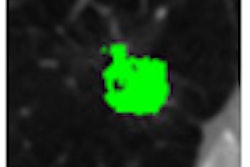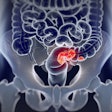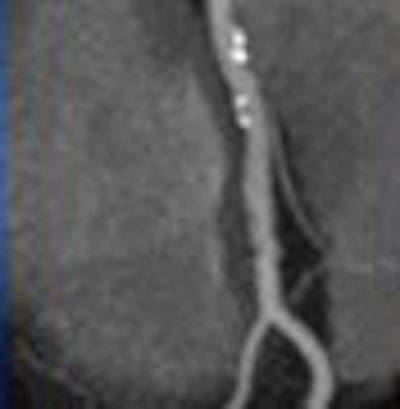
For patients with chest pain and a low risk of coronary artery disease (CAD), diagnosis of CAD based on coronary CT angiography (CTA) was more cost-effective than standard care, according to a new study from Argentina.
"We know that 64-slice MDCT has been shown to accurately rule out coronary artery disease in low-risk patients with chest pain in the emergency department compared to standard management," said Dr. Ricardo Garcia-Monaco, chief of radiology at Hospital Italiano of Buenos Aires. "However, the cost-effectiveness is not well-known."
In their study, Garcia-Monaco and his colleagues, including Dr. Fernando Abramzon, cardiologist Dr. Diego Perez de Arenaza, Dr. Mariano Sturla, Dr. Mariano Falconi, and Dr. Arturo Cagide, aimed to determine the cost-effectiveness of a primary strategy of coronary CTA for evaluating coronary artery disease in low-risk patients with acute chest pain, compared to standard management for diagnosis in the chest pain unit, Monaco-Garcia said.
"We did a mathematical model of data from patients that had received standard diagnostic management and were suspected of having acute coronary syndrome," he said in a presentation at the 2007 RSNA meeting in Chicago. Data were obtained from the hospital's prospective registry for the 1,372 patients hospitalized between July 2004 and December 2006 with acute coronary syndromes (ACS).
The mathematical model, based on multiple factors and inputs, was functional if rather "unwieldy," Garcia-Monaco said. The study end point was diagnosis of CAD, defined as one of the following:
- Chest pain with a positive coronary angiography exam
- Chest pain with a positive functional exam (i.e., treadmill, SPECT, echocardiography dobutamine stress)
- Required revascularization (percutaneous revascularization [PCI] or coronary artery bypass surgery [CABG]), proven myocardial infarction or death by one-year follow-up
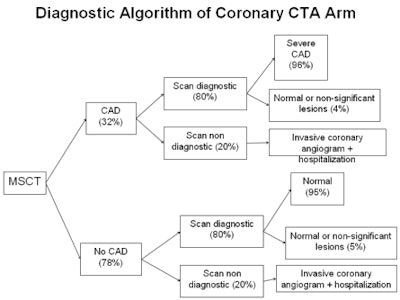 |
| Chart shows diagnostic model for patients with suspected CAD. Chart courtesy of Dr. Ricardo Garcia-Monaco and Dr. Fernando Abramzon. |
The model, based on recently published literature, assumed that coronary CTA was performed on a 64-detector-row scanner that yielded sensitivity and specificity values as high as 96% and 95%, respectively, for the diagnosis of significant CAD; and that coronary CTA would yield inaccurate results in 20% of cases (Journal of the American College of Cardiology, November 7, 2006, Vol. 48:9, pp. 1896-1910; February 27, 2007, Vol. 49:8, pp. 872-874).
The analysis was performed from the payor's perspective; therefore costs referred to total charges for the exams, Garcia-Monaco noted. All costs were calculated in U.S. dollars.
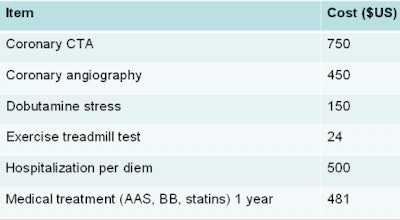 |
| Above, costs for tests, interventional procedures, and drug therapy for CAD patients. Chart courtesy of Dr. Ricardo Garcia-Monaco and Dr. Fernando Abramzon. |
Of 1,372 patients evaluated for chest pain and suspected ACS, 217 were included in the low-risk group (per American Heart Association guidelines) that constituted the study cohort.
"The patients had a negative ECG and negative biomarkers, but they had some kind of chest pain with suspicion of CAD, and that's why they were admitted," Garcia-Monaco said. Clinical outcomes, resource use, and costs were assessed over a one-year follow-up period.
The prevalence of CAD was 32% in the study cohort, and the average length of stay in the critical care unit was 2.95 ± 2.71 days, he said. In all, 33% of patients underwent coronary angiography in the critical care unit, 31% had a stress test, and 36% were discharged pending one-year follow-up.
"During the follow-up period one patient had a (myocardial infarction) and required revascularization," Garcia-Monaco said. Three patients died, two were rehospitalized for ACS, and 22 (11%) had coronary artery bypass surgery.
The results showed an average cost per CAD diagnosis of $3,553 using a dominant coronary CTA strategy, compared to $5,953 using standard management.
"We got a reduced cost by 40% with a strategy of (primary coronary CTA)," Garcia-Monaco said. "And the rate of hospitalization was reduced by 68%. (Our) analysis of the sensitivity of results shows that even increasing the cost of MDCT to $1,000 (from $500) will not modify the results."
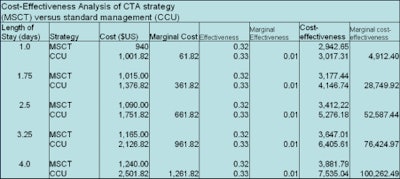 |
| Results of a mathematical model showed a significant cost advantage for a primary strategy of coronary CTA versus standard care for suspected CAD. Average cost per CAD diagnosis was $3,553 using the coronary CTA strategy versus $5,953 for the standard management strategy. The rate of hospitalization was reduced by 68% with coronary CTA strategy. Increasing coronary CTA cost from $400 to $1,000 without modifying other costs or length of stay did not obviate CTA's cost advantage. Chart courtesy of Dr. Ricardo Garcia-Monaco and Dr. Fernando Abramzon. |
Monaco-Garcia noted several limitations to the study, most significantly its reliance on a mathematical model rather than a clinical study for its conclusions. "There are many features of real life we cannot capture," he said.
The missing features included the model's assumption that coronary CTA was performed adequately. In addition, the potential of performing unnecessary exams and incurring additional costs as a result was not analyzed, Garcia-Monaco said.
"In this model, the (coronary CTA) strategy was cost-saving compared to standard management in low-risk patients with chest pain," he concluded. "And this model showed as well that it will reduce unnecessary hospitalizations."
In an e-mail to AuntMinnie.com, study author Dr. Fernando Abramzon noted that inpatient costs at his institution have, in fact, risen during the past year. "In contrast, the (coronary CTA) costs were maintained," he said. "So we expect that the cost-effectiveness analysis would be more in favor for (coronary CTA) compared to standard care if we ran this analysis today."
An audience member at the RSNA meeting questioned the authors' reliance on a positive stress test plus chest pain for a CAD diagnosis, inasmuch as stress test results can be false-positive. Monaco-Garcia said the determination of CAD was actually limited to patients with two positive functional tests and a strong suspicion of disease.
"We are working on a prospective study to test the hypothesis of this model," added study author Abramzon in his e-mail. "In the prospective study, real patients will be randomized for (coronary CTA) or standard care at the emergency department."
By Eric Barnes
AuntMinnie.com staff writer
February 29, 2008
Related Reading
ACCURACY trial compares coronary CTA to angiography, January 18, 2008
Coronary CTA study aims for lowest dose, January 11, 2008
Pending Medicare decision roils cardiac CTA, January 8, 2008
Sublingual nitroglycerin improves coronary CTA, December 31, 2007
Low-dose coronary CTA diagnoses most patients, November 28, 2007
Copyright © 2008 AuntMinnie.com







